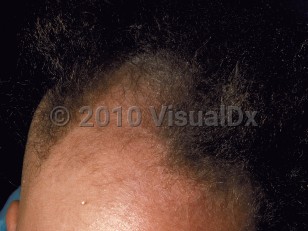Menkes syndrome - Hair and Scalp
Alerts and Notices
Important News & Links
Synopsis

Menkes syndrome, also known as Menkes kinky hair syndrome, Menkes disease, and trichopoliodystrophy, is an X-linked recessive condition (predominantly affects males) characterized by profound neurologic, connective tissue, bone, bladder, and arterial abnormalities resulting from a mutation that leads to defective copper transport. Patients appear normal at birth, but without proper copper absorption from the intestines and transport to cells, copper-dependent enzymes critical for proper functioning in multiple organ systems begin to malfunction.
Menkes syndrome is characterized by hair shaft abnormalities and hypopigmentation of the skin and hair. The most common hair shaft finding is pili torti (twisted hairs, corkscrew hairs), but other hair defects, including trichorrhexis nodosa and monilethrix, have been reported. Connective tissue alterations include skin and joint laxity, osteoporosis, arterial abnormalities, and bladder diverticula. Progressive neurodegenerative consequences are devastating and typically begin with progressive hypotonia, loss of social interaction, and subsequent severe intellectual disability. The disease is caused by a mutation in a transporting ATPase that functions to transfer copper into copper-dependent enzymes. Copper thus accumulates in the intestine and renal glomerulus but cannot be transported to target organs.
Although patients are born without complications, by 2-3 months of life, hair abnormalities can be seen, characterized by short, sparse, depigmented hair. Subsequent neurological deterioration and other connective tissue manifestations also become apparent by this age.
Diagnosis is confirmed by low serum copper and ceruloplasmin levels. Most patients who do not receive treatment die by age 3, and those who do receive therapy typically die by age 10. Death is usually due to complications from neurological deterioration and organ failure.
Milder variants of Menkes syndrome exist, including mild Menkes syndrome and occipital horn syndrome (OHS). These syndromes arise from mutations in the Menkes genetic locus that permit residual enzyme function.
Treatment of Menkes syndrome relies on intervenously or subcutaneously administered copper supplementation. However, if initiation of this therapy begins after 2 months of age, the neurodegenerative consequences cannot be prevented. In those infants where treatment was initiated in the immediate newborn period, some have had improved neurologic outcome, with only modest deficits, whereas others have not had profound improvement.
Menkes syndrome is characterized by hair shaft abnormalities and hypopigmentation of the skin and hair. The most common hair shaft finding is pili torti (twisted hairs, corkscrew hairs), but other hair defects, including trichorrhexis nodosa and monilethrix, have been reported. Connective tissue alterations include skin and joint laxity, osteoporosis, arterial abnormalities, and bladder diverticula. Progressive neurodegenerative consequences are devastating and typically begin with progressive hypotonia, loss of social interaction, and subsequent severe intellectual disability. The disease is caused by a mutation in a transporting ATPase that functions to transfer copper into copper-dependent enzymes. Copper thus accumulates in the intestine and renal glomerulus but cannot be transported to target organs.
Although patients are born without complications, by 2-3 months of life, hair abnormalities can be seen, characterized by short, sparse, depigmented hair. Subsequent neurological deterioration and other connective tissue manifestations also become apparent by this age.
Diagnosis is confirmed by low serum copper and ceruloplasmin levels. Most patients who do not receive treatment die by age 3, and those who do receive therapy typically die by age 10. Death is usually due to complications from neurological deterioration and organ failure.
Milder variants of Menkes syndrome exist, including mild Menkes syndrome and occipital horn syndrome (OHS). These syndromes arise from mutations in the Menkes genetic locus that permit residual enzyme function.
Treatment of Menkes syndrome relies on intervenously or subcutaneously administered copper supplementation. However, if initiation of this therapy begins after 2 months of age, the neurodegenerative consequences cannot be prevented. In those infants where treatment was initiated in the immediate newborn period, some have had improved neurologic outcome, with only modest deficits, whereas others have not had profound improvement.
Codes
ICD10CM:
E83.09 – Other disorders of copper metabolism
SNOMEDCT:
59178007 – Menkes kinky-hair syndrome
E83.09 – Other disorders of copper metabolism
SNOMEDCT:
59178007 – Menkes kinky-hair syndrome
Look For
Subscription Required
Diagnostic Pearls
Subscription Required
Differential Diagnosis & Pitfalls

To perform a comparison, select diagnoses from the classic differential
Subscription Required
Best Tests
Subscription Required
Management Pearls
Subscription Required
Therapy
Subscription Required
References
Subscription Required
Last Updated:01/19/2022
Menkes syndrome - Hair and Scalp

